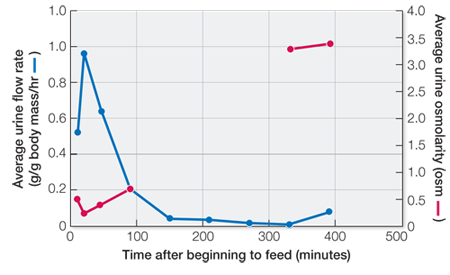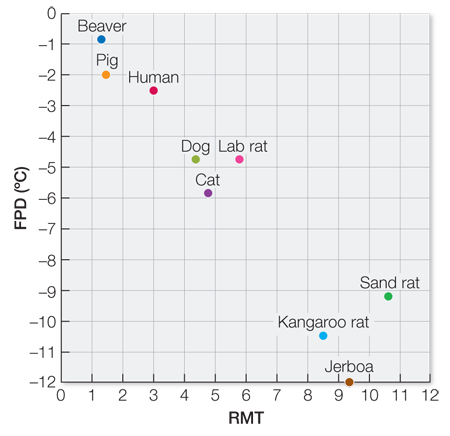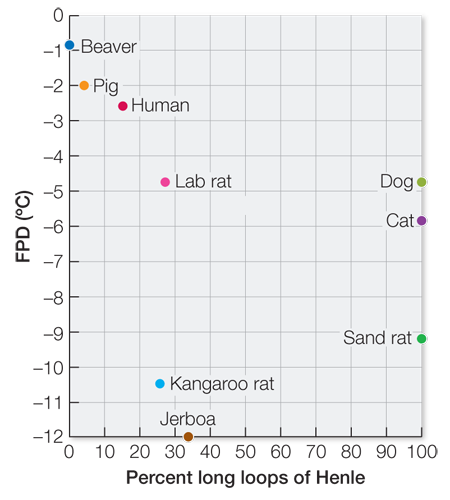Chapter 51
RECAP 51.1
A freshwater vertebrate has to osmoregulate by conserving salts and excreting water. Having a closed circulatory system makes it possible to use pressure to filter the extracellular fluid to excrete water without the loss of salts and other solutes.
An animal that lives in the intertidal may be isolated in tidal pools that can be highly diluted by rain or highly concentrated by evaporation. Artemia may survive by osmoconforming over a wide range of salinities, but it cannot survive at the extremes of fresh water or saturated salt solutions without being able to osmoregulate. Artemia uses active transport of ions across its gills to regulate hypertonically in very dilute environments and to regulate hypotonically in highly concentrated environments.
Bundles of secretory tubules drain into the salt gland ducts. The cells of those tubules actively transport Cl– ions into the lumen. Na+ follows, then water flushes the contents of the tubules into the duct.
RECAP 51.2
Ammonia is toxic and must be either excreted rapidly or detoxified. Ammonia is highly soluble in water and diffuses rapidly, so in fish, ammonia can diffuse into the blood and then be lost to the environment by continuous diffusion across the gill membranes. Because mammals are tidal breathers, the ammonia in their blood would have to reach higher levels to be lost by diffusion across alveolar membranes, so mammals detoxify ammonia by converting it into urea or uric acid.
Uric acid is considerably less soluble than urea. It precipitates out of solution in humans, in whom the total osmolarity of extracellular fluid is 300 mosm/L and therefore the contribution of uric acid to that concentration is considerably less than 300 mosm/L. Sharks and rays could not produce an extracellular osmolarity greater than that of seawater by retaining uric acid.
Most terrestrial animals have to conserve water. The advantage of excreting uric acid is that it can be precipitated out of solution in the excretory system, enabling the reabsorption, and therefore conservation, of water.
RECAP 51.3
Freshwater flatworms have to deal with a constant influx of water into their extracellular fluids by osmosis. The flame cells make it possible to filter that extracellular fluid into the protonephridia without loss of solutes, and the protonephridia can further process the filtrate by secretion and reabsorption to increase elimination of wastes and conserve solutes.
The blood plasma is filtered in capillaries to produce the coelomic fluid, and the two are similar in composition. The coelomic fluid is processed in the metanephridia through processes of tubular secretion and reabsorption to become the urine that is excreted from the body.
The insect excretory system eliminates nitrogenous waste as uric acid. By actively reabsorbing Na+ and K+ in the hindgut and rectum, the insect concentrates the waste fluid to the point that uric acid precipitates out of solution thus lowering the osmolarity of the contents of the hindgut and rectum and enabling more reabsorption of water due the active reabsorption of Na+ and K.
A-
RECAP 51.4
To move into more arid terrestrial habitats, vertebrates had to minimize their water loss and their need to have access to standing water to practice external fertilization. Whereas both amphibians and reptiles evolved various adaptations to decrease evaporative water loss from their skins, only reptiles gained independence from needing standing water to reproduce, by the evolution of the amniote egg. However, the amniote egg requires fertilization before it is encased in a protective shell, and thus the evolution of internal fertilization paralleled the evolution of the amniote egg.
The afferent arterioles bring blood into the glomerulus at high pressure to support filtration. The efferent arterioles carry the remaining blood from the glomerulus to the capillaries serving the renal tubules, where secretion and reabsorption of solutes occur.
The anatomical components of the glomerular filtration mechanism are: fenestrations in the glomerular capillary walls, the basal lamina of the capillary endothelial cells, and the slits between the processes of the podocytes of Bowman’s capsule.
The composition of the urine is made different from the composition of the blood by processes of selective active reabsorption and secretion by the renal tubules.
RECAP 51.5
The highest concentration of mitochondria would be in the renal cortex because of all of the active transport mechanisms in the convoluted tubules. The lowest concentration would be at the bottom of the renal medulla where there are only thin regions of the loops of Henle. The intermediate concentration would be in the upper level of the renal medulla because of the active transporters of Na+ in the thick ascending limb of the loop of Henle.
The thick ascending limb of the loop of Henle actively transports Na+ from the tubular fluid to the extracellular fluid, and Cl– follows. The increase in NaCl in the extracellular fluid of the medulla pulls water out of the descending limb osmotically, increasing the concentration of the tubular fluid. Since the ascending limb is not permeable to water, the more concentrated tubular fluid cannot pull water into the ascending limb. When it reaches the thick ascending limb, more NaCl is pumped out into the extracellular space. Through this mechanism, the concentration of the extracellular fluid in the renal medulla is maintained higher than the blood osmolarity.
The desert rat would have longer loops of Henle and therefore a longer renal medulla. The desert rat has evolved under selective pressure to conserve water. One way of doing that is to produce a more concentrated urine. The longer the loops of Henle, the greater the concentration gradient that can be created in the renal medulla, so the desert rat should have longer loops of Henle.
Bicarbonate in the blood is filtered into the tubular fluid, but the H+ ions transported into the tubular fluid by the tubule cells combine with that bicarbonate to produce H2CO3 (carbonic acid), which dissociates into H2O and CO2. The CO2 diffuses into the tubule cells, where its hydration to H2CO3 is catalyzed by carbonic anhydrase. The resulting HCO3– is transported across the basal end of the tubule cells and into the interstitial fluid.
RECAP 51.6
The afferent and efferent arterioles regulate GFR by changing their resistance to flow. When blood pressure rises, the afferent arterioles respond by constricting and increasing their resistance. When blood pressure falls, the efferent arterioles respond by constricting and increasing their resistance. Constriction of the afferent arterioles decreases GFR, and constriction of the efferent arterioles increases GFR. Constriction of the afferent arterioles is due to the general property of smooth muscle – when stretched, it responds by contracting.
With a decrease in blood pressure and therefore a decrease in GFR, the feedback information is a fall in solute concentration in the distal tubule. In response, the macula densa cells signal the afferent arterioles to dilate and cause the efferent arterioles to constrict by releasing renin, which initiates the conversion of angiotensinogen to angiotensin, which in turn stimulates the efferent arterioles to constrict.
The secretion of renin and the resulting production of active angiotensin are triggered by a fall in blood pressure and therefore a fall in GFR. One action of the renin−angiotensin−aldosterone system is to increase water reabsorption from the kidney to maintain blood volume. To reabsorb water, it is necessary to increase the reabsorption of Na+ to create the osmotic gradient that will pull water from the tubule fluid into the tubule cells. However, if the exchanger moved Na+ and K+ one for one, it would not create an osmotic gradient.
The chicken broth has the same osmolarity as the body fluids, so its absorption from the gut would not increase the blood osmolarity, but it would increase blood volume and blood pressure. The increase in blood pressure would stimulate the carotid baroreceptors, resulting in an inhibition of ADH release. As a result of decreased ADH, the kidney would reabsorb less water and therefore produce more urine. In addition, the increased blood volume would stimulate the release of atrial natriuretic peptide, causing increased secretion of Na+ and therefore increased loss of water, thus reducing fluid volume, blood volume, and blood pressure.
WORK WITH THE DATA, P. 1104

The average urine flow rate over the first hour is 0.18 g/g body mass/hr and for a 30-
g bat would be 5.4 g. Blood intake = 0.60 × 30 g = 18 g. Therefore the percent of the ingested volume excreted in the first hour would be 30%. The maximum concentrating factor in this experiment is 3,400 mosm/300 mosm = 11.3.
Extrapolating the missing data by connecting the two curves with a straight line would not be reasonable because the urine flow rate falls close to its lowest level at 2.5 hours (150 minutes). It is reasonable to expect that the urine osmolarity would be close to maximum at this time.
FIGURE QUESTIONS
Figure 51.4 For the freshwater planarian, the excretory product would be hypotonic to the interstitial fluid because the animal has to be excreting excess water that is entering its body by osmosis.
Figure 51.6 Na+ and K+ are transported into the Malpighian tubule so that water follows and flushes the contents of the tubule into the gut. They are transported out of the hindgut and rectum to create a concentration gradient for osmotic reabsorption of water from the gut, made possible by the precipitation of uric acid.
Figure 51.9 The blood flowing down the vasa recta always has a slightly lower osmolarity than the interstitial fluid at the same level because it is flowing and the equilibration is not instantaneous. The opposite is true for the ascending limb of the vasa recta, where the blood always has a slightly higher osmolarity than the surrounding interstitial fluid. As a result, the blood in the ascending limb absorbs water osmotically and carries some excess salt and water out of the renal medulla.
Figure 51.10 Blocking the Na+ transport out of the thick ascending limb of the loop of Henle would result in a loss or a decrease (depending on the extent of the drug action) of the concentration gradient in the medulla. As a result, the tubular fluid in the collecting duct could not be concentrated, so urine flow would increase and there would be increased loss of water.
Figure 51.16 The vampire bat has long loops of Henle like the desert gerbil.
APPLY WHAT YOU’VE LEARNED
Yes, the RMT is a good predictor of the ability of a species to concentrate its urine.

Although several species with low percentages of long loops cannot produce highly concentrated urine, some with high percentages of long loops have only moderate capacity for producing concentrated urine and three of the species that produce the most concentrated urine have low percentages of long loops. If you calculate a correlation coefficient for these data, it is 0.44, and with a sample size of 7, the p value is 0.32, so this is not a significant correlation.
A-
54 
RMT is a much better predictor of an animal’s ability to produce concentrated urine. As you can see in the percent of long loops of Henle versus FPD plot, animals such as the dog, cat, and sand rat, which have 100 percent long loops of Henle, were unable to produce the high concentrations of urine seen in the kangaroo rat and jerboa. By contrast, in the RMT versus FPD plot, animals with a high RMT, such as the sand rat, kangaroo rat, and jerboa, were able to produce higher concentrated urine than animals with a lower RMT.